List of museums and cultural institutions in Indonesia: Difference between revisions
Rochelimit (talk | contribs) typo |
Rochelimit (talk | contribs) No edit summary |
||
| Line 1: | Line 1: | ||
{{Expand list|date=August 2012}} |
{{Expand list|date=August 2012}} |
||
[[File:Museum_Nasional_Indonesia.jpg|thumb|350px|right|The National Museum of Indonesia in [[Jakarta]].]] |
[[File:Museum_Nasional_Indonesia.jpg|thumb|350px|right|The National Museum of Indonesia in [[Jakarta]]. The oldest museum in Indonesia, the society of the museum was established in the 18th century. The building in the photograph, the second building of the museum's society, was also the oldest museum building in Indonesia which still exist, dating from the 19th century.]] |
||
These are '''lists of museums and cultural institutions in Indonesia'''. This list contains some of the more notable, by its regional location. |
These are '''lists of museums and cultural institutions in Indonesia'''. This list contains some of the more notable, by its regional location. |
||
Revision as of 18:15, 22 February 2013
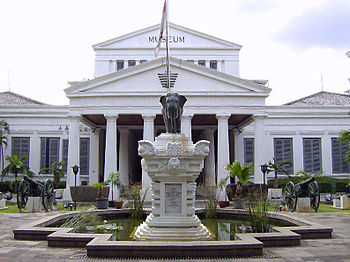
These are lists of museums and cultural institutions in Indonesia. This list contains some of the more notable, by its regional location.
These lists include all museums and cultural institutions in Indonesia (including aquariums, zoos, and botanical gardens, following the definition of the International Council of Museums). Heritage buildings such as candi, mosques, colonial churches and buildings with no site museum should not be placed in the list.
History
Colonial period
Prior to the 20th century, the Government of the Netherlands Indies paid little attention to the culture of Indonesia. Study of traditional culture and archaeology was left to individuals or non-governmental institutions. Some of these are the non-governmental Batavian Society of Arts and Science, and individuals such as Sir Stamford Raffles, who wrote a valuable archaeological history of Java in 1818, and other important figures such as Dr. Snoeck Hourgrogne.[1]


The first museum in Indonesia seems to have been that built by Rumphius in Ambon, built in 1662. Nothing remains of it except books written by himself, which are now in the library of the National Museum. Its successor was the Batavia Society of Art and Science, established on 24 April 1778. It built a museum and a library, played an important role in research, and collected much material on the natural history and culture of Indonesia. It later came under the direct control of the British Lieutenant-Governor Raffles who, among other things, provided it with a new office building for the museum and library administration. The museum collection and library continued to grow, and in 1862 the government built, in the center of the city, what is now the National Museum, the previous building is now Museum Wayang. The whole collection was transferred to the Government of the Republic of Indonesia in 1962. [2]
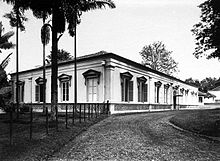
The Batavia Society of Art and Science also specialized in social sciences. In 1817 it made the plans for the Hortus Botanicus Bogoriense in Bogor. In 1894 it set up the Museum Zoologicum Bogoriense. The Bibliotheca Bogoriense made Bogor into an important center of biological science.[2]
Except for the Radya Pustaka Museum in Surakarta (1890), no other major museums were established in the 19th century. It was only in the 1930s that local museums began to appear, usually privately initiated, by civil servants and Catholic and Protestant missionaries. These museums are praiseworthy, but are not always in expert hands, and are often run by boards which do not always function continually.[2] Some museums suffer from the lack of regular resources, and some have disappeared completely, e.g. the Karo Museum in Berastagi, North Sumatra, set up by Dr Neuman, was abolished during the Japanese occupation (1942-45); and the Banjarmasin Museum built by Dr Malinkrodt, an expert on customs and traditions in Kalimantan, was burned down.[2]
At the beginning of 20th century, the colonial government became interested in the maintenance and restoration of cultural remains. In 1901 it set up the Commissie in Nederlandsch Indie voor Oudheidkundige Onderzoek van Java en Madoera, headed by Dr J. L. A. Brandes. In 1913, this became the more effective Oudheid-kundige Dienst van Nederlandsch Indie (Archaeological Service), under Professor Dr. N.J. Kromm. The government also employed officials to make a study of local languages and started the Kantoor voor Inlandsche Zaken.[1]
In 1918 Balai Poestaka was created to publish books of literary value in Malay and local languages. Malay was taught in schools next to the local language. Prospective civil servants were obliged to study the language and customs of the region they were to work in. Training was given in Leiden, in the Netherlands. Native Indonesians also came to realize the importance of their national culture in awakening nationalism, part of a general contemporary phenomenon in Asia. This nationalism was pioneered by Budi Utomo in 1908 in the STOVIA, whose building, the School for Javanese Doctors, is converted into a museum today.[1]
Modern technology and cultural change leads to disappearance of indigenous handicrafts. There was no longer a market for plait-work, textiles, earthenware, and brass, silver and gold objects. The result was a gradual process of cultural impoverishment. A need for money forced people to sell their heirlooms on the market, and many objects that should have been kept in Indonesia found their way to foreign countries. This condition prompted the building of the Sana Budaya Museum in Yogyakarta in 1935. Dr. F. D. K. Bosch, then Head of the Archaeology Service, and now Museum Director of the Batavia Society, first referred to cultural impoverishment, and the need for historical and cultural museums, to encourage people to appreciate their own products and to improve the quality of their handicrafts.[2]

The late Director of the Municipal Museum of Surabaya, Von Faber, emphasized the role of museums in education. The famous painter, Walter Spies, actively helped in the creation and management of the Bali Museum in Denpasar. Unfortunately, the decision to establish museums at the time was not matched by a determination to find experts capable of managing them properly. Only a few language experts like Professor Husein Jayadiningrat and Professor Dr. Purbacaraka were interested in museums-mainly because the university produced few experts in history and the social sciences, but concentrated on training physicians, lawyers, technicians and civil servants. It was not until independence that the social sciences began to develop.[2]
The Japanese occupation (1942-1945) indirectly stimulated Indonesian culture, and especially language, drama and the arts. A cultural center (Keimin Bunka Sidosho), created to promote Indonesian art and culture, and Poetera, headed by national leaders, provided opportunities for exhibitions, performances and so on.[1]
Post-independence
Pursuant to Article 32 of the Constitution, the government established the Ministry of Education and Culture. Its Cultural Department had separate Archaeological, Art, and Language Divisions. The Art Division set up various educational institutes including the Indonesian Academy of Fine Arts, the Indonesian School of Music (both in Yogyakarta), and Karawitan Conservatoire in Surakarta (Central Java). The original Language Division was divided in 1952 into two parts, one retaining the name of Language Division in the Cultural Department, the other being included in the Institute of Literature (the former Instituut voor Taal en Cultuur Onderzoek, Faculteit der Lettera en Wijsbegeerte van de Universiteit van Indonesi). In the same year (1952), the Cultural Department opened cultural offices in the provinces: Medan (North Sumatra), Bukit Tinggi (Central Sumatra), Palembang (South Sumatra), Jakarta, Bandung (West Java), Surabaya (East Java), Makassar (South Sulawesi), Denpasar (Bali) and Ambon (Moluccas). [1]
In 1956, the following changes took place: (a) The Archaeological Division became an autonomous Institute of Archaeology; (b) The Language Division became the Sub-Division of Customs and Traditions (remaining in the Cultural Department); (c) The other part of the former Language Division was incorporated into the Language Division of the Literary Faculty of the University of Indonesia; (d) The Cultural Department was given a new responsibility: museum management (Museum Section).[1]
New Order Period

As a result of an extensive ministerial reorganization of the New Order period (1960-1969), the Cultural Department was incorporated into the Directorate of Culture, while the Museum Section became an autonomous National Museum Institute. In consequence the Ministry of Education and Culture had one Directorate (Culture) and four institutes, namely Archaeology, Language and Literature, National Museum, History and Anthropology. The Inspectorate of Provincial Culture was made responsible for setting up cultural offices in the provinces. Under General Suharto, further changes were made in 1966 in the ministries. Education and Culture was organized into five Directorates-General. The Directorate-General of Culture has five directorates, namely Art, Cultural Education, Archaeology and History, Museums, Language, and Literature.[1]
During this period, the Armed Forces History Center expanded and encouraged the development of museums of militaristic in nature. Some of these museums for which the Armed Forces was directly responsible are Satria Mandala Armed Forces Museum (opened in 1972), Museum of the Sacred Pancasila Monument (1982), Museum of Eternal Vigilance (1987), Soldiership Museum (1987), and the Museum of Communist Treachery (1993). The collection of these museums feature relics, photographs, and weapons. Dioramas are extensively used by the Armed Forces History Center, whom method was chosen because of a general lack of perceived value in historical objects in Indonesia as well as the lack of funds.[3]
Today
The number of museums in Indonesia in 1945 was 26 (including aquariums, zoos, and botanical gardens, following the definition of the International Council of Museums (ICOM)). Between 1945 and 1968, this increased to 46. Today there are 281 museums in Indonesia (2010),[4] 80 of which are State Museums.[5]
In Indonesia, the increase of museums in numbers has not yet been matched by an increase in quality. Buildings are often unsuitable for display and for socio-educational activities; competent staffs are lacking; the public does not yet appreciate the educational role of museums; funds are lacking to maintain collections and extend building; and so on. There are not enough museums for 120 million inhabitants and a large number of State and private universities. Big cities like Jakarta, Medan, Surabaya, Bandung and Semarang need centers for science and culture, and museums as places of study and enjoyment.[2]
Museums by region
Jakarta
Jakarta contains the most museums in Indonesia with over 50 museums within its 661 square kilometers area. The museums in Jakarta cluster around the Central Jakarta Merdeka Square area, Jakarta Old Town, and Taman Mini Indonesia Indah.
The Jakarta Old Town contains museums that are former institutional buildings of Colonial Batavia. Some of the notable museums are: Jakarta History Museum (former City Hall of Batavia), Wayang Museum (former Church of Batavia), the Fine Art and Ceramic Museum (former Court House of Justice of Batavia), the Maritime Museum (former Sunda Kelapa warehouse), Bank Indonesia Museum (former Javasche Bank), and Bank Mandiri Museum (former Netherlands Trading Society).
Several museums clustered in central Jakarta around the Merdeka Square area include: National Museum of Indonesia, Monas, Istiqlal Islamic Museum in Istiqlal mosque, and Jakarta Cathedral Museum on the second floor of Jakarta Cathedral. Also in the central Jakarta area is the Taman Prasasti Museum (former cemetery of Batavia), and Textile Museum in Tanah Abang area.
The recreational area of Taman Mini Indonesia Indah in East Jakarta contains fourteen museums from the 1970s within its complex.
North Jakarta and Thousand Islands

- Jakarta Old Town
- Bentara Budaya Jakarta
- Museum Lukisan Universitas Pelita Harapan
- Museum 12 Mei Universitas Trisakti
- Jakarta Textile Museum
- Gedung Joang '45
- Gedung Kesenian Jakarta
- Gedung Mohammad Hoesni Thamrin
- Jakarta Cathedral Museum
- Jakarta Planetarium
- Monas
- Museum Adam Malik (showcasing life, career and works of Adam Malik, the 3rd vice president of Indonesia, who were also the country's notable journalist, literary figure, and diplomat)
- Museum Anatomy Fakultas Kedokteran Universitas Indonesia
- Museum Jenderal Besar DR. Abdul Haris Nasution
- Museum Kebangkitan Nasional
- Museum Pers ANTARA
- Museum Perumusan Naskah Proklamasi (the site where the text of the nation's proclamation of independence was composed in 1945)
- Museum Puri Bhakti Renatama
- National Gallery of Indonesia
- National Museum or Museum Gajah
- Museum Sasmita Loka Jenderal Ahmad Yani
- Sumpah Pemuda Museum
- Taman Prasasti Museum
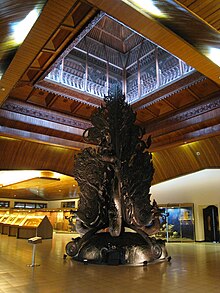
- Museum Loka Jala Srana
- Museum of PKI Treason
- Monument of Sacred Pancasila
- Taman Mini Indonesia Indah
- Asmat Museum
- Indonesia Fauna Museum
- Indonesia Museum
- Istiqlal Museum
- Indonesia Soldiership Museum
- Insect Museum and Butterfly Park
- Komodo Museum and Reptile Park
- Museum of Electricity and New Energy
- Oil and Natural Gas Museum
- Sports Museum
- Lighting Museum
- Museum of Science and Technology
- Indonesia Stamp Museum
- Purna Bhakti Pertiwi Museum
- Heirloom Museum
- Telecommunication Museum
- Timor Timur Museum
- Transport Museum
- Museum Basuki Abdullah
- Museum Dirgantara Mandala
- Museum Harry Darsono (showcasing works and career of Harry Dharsono, Indonesian famous fashion designer)
- Museum Kriminal (Mabak)
- Museum Layang-Layang
- Museum Manggala Wanabhakti
- Museum Polri (Official museum for showcasing the history of Polri, the Indonesian national police force)
- Reksa Artha Museum
- Satrian Mandala Museum
- Waspada Purbawisesa Museum
Yogyakarta
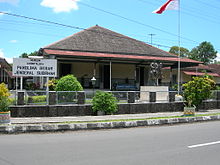
Due to the importance of Yogyakarta during the war of independence from the Dutch, there are numerous memorials and museums. Monument Yogya Kembali and Fort Vredeburg are two major museums of about 11 named in the city.
- Affandi Museum
- Batik Museum
- Fort Vredeburg Museum
- Hamengkubuwono IX Museum
- Kraton Yogyakarta Museum
- Yogya Kembali Museum, Sleman Regency
- Museum Sasmitaloka Panglima Besar Jenderal Soedirman
- Prambanan Museum
- Sana Budaya Museum (1939)
- Ullen Sentalu Museum
- Wayang Kekayon Museum
Java
- Asian–African Conference Museum, Bandung
- Bandung Geological Museum, Bandung (1928)
- Barli Museum, Bandung
- Museum Margasatwa Taman Sari, Bandung (1933)
- Bogor Zoological Museum, Bogor (1894)
- Ethnobotanical Museum, Bogor
- Indonesia Post Museum, Bandung
- Museum Perjuangan Jawa Barat, Bandung
- Museum Perjuangan Jawa Barat, Bogor
- Museum PETA, Bogor
- Museum Prabu Geusan Ulun, Purwakarta
- Museum Tanah Nasrel, Bogor
- id:Museum Wangsit Mandala Siliwangi
- Sri Baduga Museum, Bandung
- Tambaksari's Site Museum, Ciamis
- Museum Sultan Sepuh Kasepuhan, Cirebon
- Museum Kacirebonan, Cirebon
- Museum Linggarjati, Kuningan
- Museum Amerta Dirgantara, Subang
- Museum Percandian Batujaya, Karawang
- Museum Palangan B. Kokosan, Sukabumi

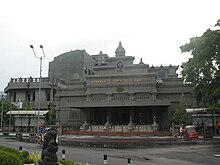
- Ambarawa Railway Museum, Ambarawa
- Indonesian Record Museum
- Keraton Surakarta Museum
- Kretek Museum, Semarang
- National Museum of Press, Solo
- Pekalongan Batik Museum, Pekalongan (1972)
- Radya Pustaka Museum (1890)
- Borobudur Museum
- Samudra Raksa Museum
- Ronggo Warsito State Museum, Semarang
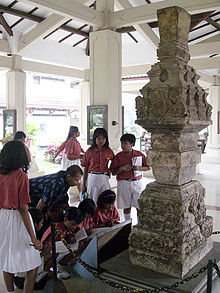
- Brawijaya Museum, Malang
- Mpu Tantular State Museum
- Museum Tugu Pahlawan, Surabaya
- Trowulan Museum, Trowulan (1987)
Lesser Sunda Islands
- Agung Rai Museum of Art
- Bali Museum (1930)
- Blanco Renaissance Museum
- Buleleng Museum, Singaraja
- Le Mayeur Museum, Sanur
- Museum Rudana
- Museum Semarajaya
- Neka Art Museum, Ubud (1982)[6]
- Purbakala Archaeological Museum
- Puri Lukisan Museum
West Nusa Tenggara
East Nusa Tenggara
Sumatera
Most museums in Sumatra specialized on cultural heritage such as textiles and other traditional artifacts.

- Aceh Museum, Banda Aceh (1915)
- Aceh Tsunami Museum, Banda Aceh[7]
- Museum Malikussaleh, Lhokseumawe
- Museum Balige, Balige
- Museum Perjuangan Bukit Barisan, Medan
- Museum Juang 45, Medan
- Museum Simalungun, Pematang Siantar
- Museum Huta Balon Simanindo, Simanindo
- Museum Rumah Bolon Pematang Purba, Pematang purba
- Museum Pusaka Nias, Nias (1993). The only museum in Nias, was destroyed by the Boxing Day Tsunami. A new building for the museum has been constructed.
- Museum Zoologi Pematang Siantar
- North Sumatra Museum, Medan
- TB Silalahi Center, Balige Subdistrict (2008)
Riau and Riau Islands
- Museum Ikan Bagansiapiapi, Rokan Hilir
- Museum Kandil Riau, Tanjung Pinang
- Museum Sang Nila Utama, Pekanbaru (1994)
- Museum Istana Siak Sri Indrapura, Indrapura
- Museum Sultan Sulaiman Badrul Alamsyah, Tanjung Pinang
- Museum Tionghoa Bagansiapiapi, Rokan Hilir

- Adityawarman Museum, Padang (1977)
- Museum Rumah Kelahiran Buya Hamka, Agam (2001)
- Tri Daya Eka Dharma Museum, Bukittinggi
- Museum Bung Hatta, Bukittinggi
- Museum Gempa 30 September 2009, Padang
- Gedung Joang '45, Padang
- Goedang Ransoem Museum, Sawahlunto
- Galeri Tambang Mbah Soero, Sawahlunto
- Information Center of Minangkabau Culture, Padang Panjang (1990)
- Museum Rumah Adat Baanjuang, Fort de Kock, Bukittinggi
- Museum Rumah Kelahiran Buya Hamka, Agam Regency
- Railway Museum, Sawahlunto
- Museum Taman Bundo Kandung, Bukittinggi (1934)[8]
- Museum Tri Daya Eka Dharma, Bukittinggi (1973)
- Museum Zoologi Bukittinggi, Bukittinggi
Bengkulu
Jambi
South Sumatra and Bangka–Belitung Islands

- Balaputradewa Museum, Palembang
- Museum UPT Belitung, Belitung
- Sriwijaya Museum, Sriwijaya Kingdom Archaeological Park, Palembang
- Sultan Mahmud Badaruddin II Museum, Palembang
- Textile Museum, Palembang
Kalimantan
Most museums in Kalimantan specialized on cultural heritage such as textiles and other traditional artifacts. Central Kalimantan
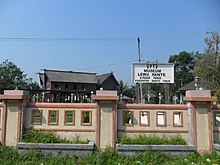
- Kalimantan Art Gallery
- Mulawarman State Museum, Tenggarong Subdistrict
- Museum Kayu Tuah Himba, Tenggarong Subdistrict
- Museum Perjuangan Merah Putih, Sanga-Sanga Subdistrict


- Candi Agung Museum, Amuntai
- Lambung Mangkurat State Museum, Banjarbaru
- Wasaka Museum, Banjarmasin
Sulawesi
Most museums in Sulawesi specialized on cultural heritage such as textiles and other traditional artifacts.
- Manado Wanua Paksinata North Sulawesi Provincial Museum, Manado
- Kaili Souraja Museum, Kaili
- Palu Central Sulawesi Provincial Museum, Palu
- Museum Batara Guru, Wara Utama Subdistrict
- Museum La Galigo, Fort Rotterdam, Makassar
- Sungguminasa Balla Lompoa Museum, near Ujung Pandang
- Buton Palace Museum, Baubau, Buton Island
- Southeast Sulawesi State Museum, Kendari
The Moluccas
Ambon was the site of the first recorded museum in Indonesia, a botanical museum built by Georg Eberhard Rumphius in 1662. Nothing remains of it except books written by himself, which are now in the library of the National Museum of Indonesia.
Today, museums in the Moluccas specialized on cultural heritage such as Ambonese traditional artifacts.
- Siwa Lima State Museum, Ambon (1973)

- Museum Memorial Kedaton Sultan Ternate, Kota Ternate Utara Subdistrict
West Papua
See also
References
- ^ a b c d e f g Cultural Policy in Indonesia (PDF). Paris: UNESCO. 1973. pp. 14–17. Retrieved February 17, 2013.
- ^ a b c d e f g Cultural Policy in Indonesia (PDF). Paris: UNESCO. 1973. pp. 29–33. Retrieved February 17, 2013.
- ^ McGregor, Katharine E. (2007). History in Uniform: Military Ideology and the Construction of Indonesia's Past. Singapore: NUS Press. pp. 6–10. ISBN 9971693607, 9789971693602.
{{cite book}}: Check|isbn=value: invalid character (help) - ^ Ruslan Burhani (2010). "Sebagian Besar Museum Indonesia Kurang Interaktif". Antara News (in Indonesian). Retrieved February 18, 2013.
- ^ "Jumlah Pengunjung Museum di Indonesia" (PDF). Pusat Pengelolaan Data dan Sistem Jaringan (in Indonesian). BAPPENAS, Depbudpar. 2009. Retrieved February 18, 2013.
{{cite web}}: no-break space character in|publisher=at position 10 (help); no-break space character in|work=at position 6 (help) - ^ Agus Aris Munandar (2011). Sejarah Permuseuman di Indonesia (in Indonesian). Direktorat Permuseuman.
- ^ http://news.bbc.co.uk/2/hi/7905770.stm
- ^ Vaisutis, Justin (2007). Indonesia. Lonely Planet. p. 443. ISBN 1741044359, 9781741044355. Retrieved February 18, 2013.
{{cite book}}: Check|isbn=value: invalid character (help)
